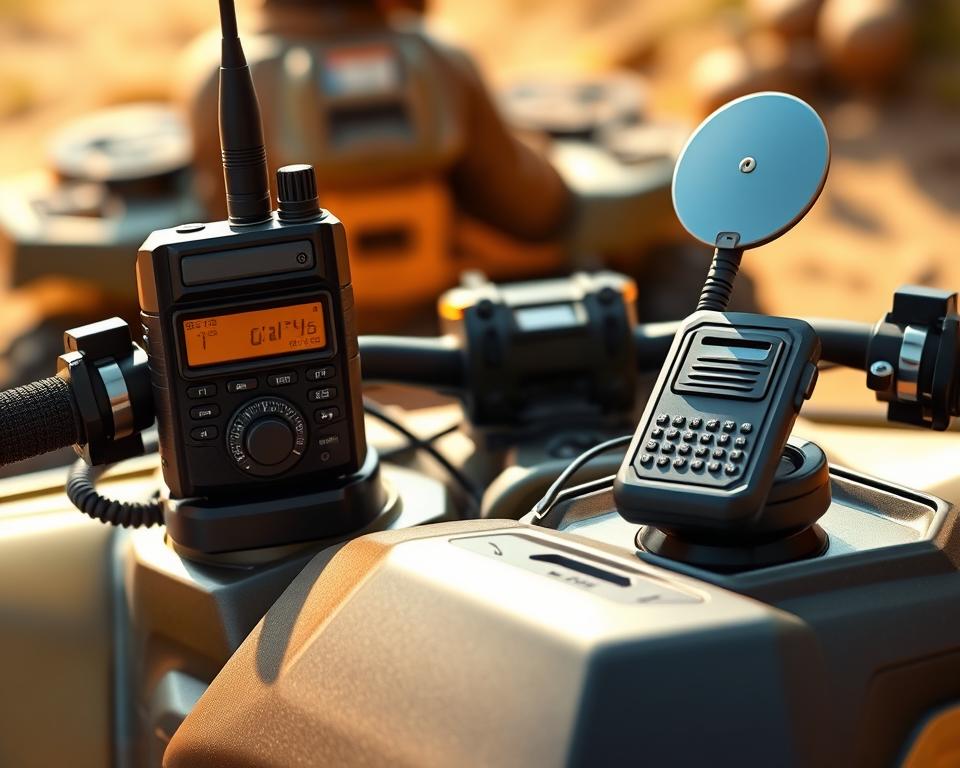Avoiding ATV/UTV Gearing Mistakes for Newbies
Did you know that nearly 35% of new ATV and UTV owners face gear selection issues within their first year? This statistic underlines the importance of grasping ATV gear ratios for beginners. Beyond performance, proper gearing is a key safety factor. Let’s dive into gearing missteps, care routines, and top can-am defender lift kit tips to enhance your rides.
Core Lessons

- Understanding gear ratios is vital for optimal ATV/UTV performance.
- Typical gear mistakes compromise safety on uneven ground.
- Regular maintenance is key to preventing UTV transmission issues.
- Choosing the right gear boosts trail enjoyment.
- Following upkeep advice extends your ATV’s life.
Understanding ATV and UTV Gear Ratios
Gear ratios are vital for the performance of ATVs and UTVs. They shape acceleration and pulling strength. This affects acceleration and the vehicle’s ability to pull loads. Custom gearing shifts focus from speed to torque or vice versa.
Selecting proper gears unlocks engine potential. Too low a ratio may leave you underpowered on inclines. Overgearing sacrifices quickness for top-end speed.
Adjusting reduction influences handling in mud, sand, and rock. Tuning ratios lets you fine-tune speed vs. torque. This ensures the machine operates efficiently, whether prioritizing speed or torque. Optimal ratios deliver smoother use and better MPG.
Common Gearing Oversights for New ATV/UTV Owners
Correct gearing secures top output and trail safety. Rookies often miss key selection factors. Understanding the effects of wrong gear choices and selecting the right one for your terrain can greatly improve your ride. Plus, it prevents mechanical setbacks.
Impact of Incorrect Gear Selection
Misgearing risks crashes and costly damage. The wrong gear can slow down acceleration, affect braking, and cause excessive wear. Such errors endanger everyone, from driver to bystanders. Using maintenance best practices wards off these hazards.
Choosing the Right Gear for Terrain
Trail type dictates ideal gearing. Climbing requires low-end grunt from smaller ratios. On flat terrains, higher gears help increase speed. Soft ground demands careful gear choice for grip. Understanding trail types secures fun and safety.
The Importance of Proper ATV Maintenance
Scheduled service avoids surprises on the trail. Using upkeep best practices stops breakdowns and protects riders. A well-planned maintenance schedule focuses on the gear system’s health.
Regular Inspection and Maintenance
A detailed inspection checklist is essential for spotting issues early. Routinely examine gearbox teeth, brake pads, rubber, and belts. Routine checks lead to peak performance. Here are some critical inspection points to remember:
- Examine gear alignment and wear.
- Ensure all fasteners are tight.
- Assess brake fluid and hydraulic systems.
- Inspect tire pressure and tread depth.
- Inspect battery terminals and cables for buildup.
Fluid Changes and Gear Health
Fluid quality is critical for UTV drivetrain maintenance. Regularly changing engine oil, gear oil, and coolant prevents grime buildup. Fresh oil cuts wear and heat for lasting components. Adopting this routine preserves drivetrain health and trail readiness.
| Fluid Type | Recommended Change Interval | Benefits of Regular Change |
|---|---|---|
| Engine Oil | Every 50-100 hours | Cuts friction and boosts power |
| Gear Oil | Every 100-200 hours | Improves shifting, minimizes gear damage |
| Antifreeze | Annually | Stops boil-overs and freezes |
Sticking to this plan ensures uninterrupted trail fun. It turns rides into stress-free experiences.
Common ATV Gear Shifting Problems
Rookie riders struggle with smooth shifts. Developing fluid shift skills elevates trail enjoyment. It reduces frustration on the trails. Synchronizing engine speed and clutch engagement stops misshifts.
Learning to Shift Smoothly
Developing smooth shifting techniques requires a few practices. Start by getting to know your ATV engine’s rhythm. Careful engagement protects internals and stops wear. Blending throttle with clutch release ensures seamless shifts.
Rehearse gear changes in a safe area before heading out. Focus on gentle throttle application during each gear change.
Recognizing Signs of Gear Issues
Spotting problems early prevents breakdowns. Listen for unusual sounds like grinding or popping, which may mean gears aren’t engaging right. Stuck gears or false neutrals are warning signs. Fixing problems fast keeps you safer on the trail. Addressing ATV gear shifting problems properly maintains vehicle performance and boosts your confidence while riding.
Understanding UTV Transmission Issues
Dealing with UTV transmission problems can be tough, but knowing the common issues is vital for troubleshooting. Owners often face issues like slipping gears or odd noises. This section delves into these frequent problems and offers a detailed approach to diagnose and fix them. Drawing on proven UTV repair protocols.
Diagnosing Common Problems
Noticing early clues saves you from expensive repairs. Common issues include:
- Gears that pop out under load, risking accidents.
- Unusual sounds, such as grinding or whining, indicating mechanical damage.
- Signs of fluid seepage that threaten gearbox health.
Routine checks uncover faults early. This allows for prompt action. Missing early clues damages your ride and wallet.
Solutions for Troubleshooting UTV Transmissions
Repairing gearbox problems calls for methodical steps. Follow these steps for effective troubleshooting:
- Ensure gearbox fluid is at spec, then add if low.
- Look for wet spots beneath the transmission.
- Assess internal components for wear or chipping.
- Test drive the UTV at various speeds to monitor gear engagement and responsiveness.
- Check OEM guides for model-specific repair advice.
Leveraging a proven guide speeds up repairs. Grasping drivetrain theory helps maintain your rig. It greatly enhances your vehicle’s longevity and efficiency.
ATV Clutch Adjustments and Their Benefits
Accurate clutch tuning unlocks seamless shifts. Bad clutch setup leads to gear grind and confusion. Frequent tuning enhances clutch grip and shift precision.
Fine-tuning clutch engagement matters. An optimally adjusted clutch ensures quick and smooth gear changes. It refines acceleration and comfort across all conditions.
Ignoring clutch adjustments can harm performance and wear out parts. Proper maintenance leads to smoother shifts and better engine response. All riders benefit from clutch care to maintain top performance.
Mastering the Art of Gear Shifting
Excelling at transitions elevates your trail adventures. You need mechanical insight and precise timing to nail each shift. Beginners should focus on the rhythm of shifting gears. Consistent timing makes shifts effortless and more efficient.
Proficient gear shifting demands practice, across various riding conditions. Knowing shift points for hills, flats, and mud secures handling. Dropping a gear before a climb preserves torque and control.
- Rehearse clicks slowly to gain control.
- Listen and feel each gear engagement.
- Gradually incorporate more challenging terrains to test your skills.
Getting in sync with your ride ensures perfect shifts. Heed revs and shakes to know shift points. This helps determine the optimal moments to shift. This natural touch produces fluid gear changes for maximum enjoyment.
Best Practices for UTV Gear Selector Problems
Managing UTV gear selector problems demands a proactive maintenance and diagnostic approach. Regular inspections are key to spotting issues early. Learning proper lever use minimizes failures. Routine checks should include visual inspections of the selector linkage and fluid levels, which are vital for performance.
If you suspect a fault, inspect the lever assembly for bends or breaks. Unusual noises can also hint at problems. Simple adjustments and cleaning often solve issues without needing major repairs. A routine plan stops small faults from growing.
Using a systematic approach, like documenting gear performance under different conditions, helps identify specific problems. These best practices not only extend the gear selector’s life but also make riding safer and more enjoyable.
Tips for Enhancing Gear Performance
Maintaining optimal gear performance requires a proactive approach. Regular maintenance is key to improving ATV efficiency. Monitor fluids, look for damage, and fine-tune as required. Catching nicks before they worsen saves you big bucks.
Selecting proper reductions yields prompt acceleration and fluid movement. Assessing ground conditions guides your ratio picks. It influences your launch and maximum velocity. Consulting reputable brands like American Off-Roads, which offer aftermarket modifications, can help with UTV performance enhancements.
Applying gear performance tips across tires, shocks, and load balance boosts efficiency. Those mods lead to stable, confident rides across tough terrain. Your rides become more fun and less fatiguing. Implementing these strategies will allow riders to navigate with confidence while enjoying the thrill of the ride.
Final Thoughts
Nailing gear selection unlocks peak power and protection. Knowing how to choose the right gear for different terrains greatly improves your ride. Dodging typical pitfalls and choosing wisely delivers memorable, safe outings.
No less crucial is keeping your drivetrain in top trim. Routine inspections and care fend off failures and boost lifespan. Good upkeep maximizes output and secures your rides in all conditions.
Merging smart ratio choice and regular upkeep yields the best off-road enjoyment. Following these guidelines paves the way for endless trail excitement.
Frequently Asked Questions
Standard gear ratios on off-road rigs?
Ratio specs differ greatly by manufacturer and use case. They usually range from 3:1 to 5:1. Low-end ratios yield higher pulling power. Higher ratios, on the other hand, can increase top speed on flat terrain.
Signs of misgearing for different surfaces?
Using the wrong gear can lead to loss of control, excessive engine revving, or poor acceleration. Mud, sand, rocks, and snow each call for tailored gear choices.
What are some signs that my ATV/UTV needs maintenance?
Head off issues if shifts go crunchy, the box hums, oil drips, or power falls off. Regular checks of the gear system can prevent major issues.
When to swap your drivetrain oils?
Aim for a fluid swap between 1,500–2,500 miles or annually, whichever comes first. Fresh fluids promote crisp shifts and gearbox longevity.
How to shift gears without jerking?
For smooth gear shifting, practice coordinating the throttle and clutch. Gradually release the clutch while pressing the throttle to match engine speed with wheel speed.
Steps to diagnose gearbox problems?
First, inspect oil, then note any unusual gearbox sounds. Verify oil clarity and fill. Then, perform a basic diagnostic to identify any mechanical failures.
Why adjust your ATV clutch?
Proper clutch adjustments are essential for smooth gear transitions. An improperly set clutch can cause shifting difficulties and may lead to premature wear on transmission components.
Optimizing gears for varied ground?
Test multiple gearing options and look into quality mods by American Off-Roads. Routine upkeep—fluid swaps and gear checks—boosts efficiency.
Addressing a bad gear selector?
Regular inspections and routine maintenance are key. For jams or mis-engagements, follow your manual’s diagnostic steps.
Beginner pitfalls in gear selection?
Rookies tend to ignore ratio basics, delay upkeep, or misgear for mud, rock, or hills. These oversights can lead to inefficient operation and safety concerns.


